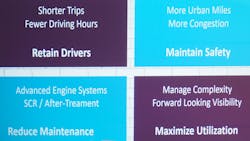HOUSTON. It's Truck Driver Appreciation Week, and Trimble Transportation Mobility President Thomas Fansler had some broader praise for trucking, which he called "North America's greatest industry." But the industry is facing some difficult headwinds, he said at Trimble's in.sight 2018 user conference here, including compounding trends that are causing "an increasing imbalance in supply and demand."
First, the good: Fansler pointed to the economic importance and significant impact on all our lives that trucking has. All-inclusively, the trucking industry employs almost one out of 10 individuals, and folding in pipelines, moves more than 70% of domestic freight tonnage.
Trucking generated $676 billion in revenue last year and contributed $19 billion in federal highway use tax along with $23 billion in state highway use tax, he noted, "and that's half of all the money spent on our roads and highways—it means better roads for all of us and a lower tax burden."
Trucking is the means by which most fresh food, medicine, home goods, building materials, and more reach consumers. But all that importance hasn't gone to its head.
"We're also an industry with very little pretense that shares the same values as working families everywhere," Fansler said. "I'm proud to say I work in the North American trucking industry, as do all of you; you are part of North America's greatest industry."
Now, the not so good—or at least the more complicated. Over the last four years, Fansler explained, freight tonnage has increased by 9%, and the U.S. Bureau of Labor Statistics reports that employment in the trucking industry is up 4.3% over that same period.
But Trimble has tracked a dip in truck driver productivity. "Our survey of large truckload carriers indicates that driving hours over the last four-year period are down 4%," said Fansler, "and the drop in productivity is even greater in the owner-operator segment."
That could be due in part to stricter adherence to federal Hours of Service rules with electronic logging devices now required for commercial drivers.
"We also know, as we try to attract more drivers to our industry, that the Hours of Service rules are putting more drivers on the road during peak driving hours," Fansler said. "And the rise in e-commerce and home delivery correlates to an 18% increase in urban miles traveled, even as rural miles traveled decline."
Congestion and vehicles on the road during peak hours are combining to increase risk for truck drivers and threaten safety. Studies have shown that driving from 6 a.m. to 6 p.m. carries a 50% higher risk of a crash per mile traveled, he contended.
Then there's driver turnover, which Fansler noted was at a lofty 94% as of April among large truckload fleets, a more than 20% jump from the prior year. As drivers bounce from company to company, it means new routes, new trucks, and new organizations to get used to, which can detract from the confidently safer operation that comes with routine.
A shortage of drivers, less driver productivity, and increasing need to move goods has led to "sharply higher freight rates," Fansler noted, which is good for carriers. But it's not so simple: the higher numbers of trucks needed and increasing vehicle density in areas of highest volumes and demand are causing spikes in congestion, which costs fleets money.
Fansler cited a figure of $0.23 cents per mile as the ding in revenue trucking takes due to congestion, and that amount is up a sizeable 25% from 2017. "More importantly, these trends create serious concerns for driver safety," he added.
The backdrop for freight and overlaying trends have fleets competing with each other in more ways than one. Part of Trimble's message here at in.sight is that it's a good time to explore the possibilities of a deeper technology integration and how it can benefit your business, as the company has strengthened its branding and announced a number of product enhancements and updates.
Some of those benefits Trimble's products target include improved—even as far as predictive—driver retention, more accurate ETAs for deliveries and stops, or better predictive maintenance for trucks.
"Add in an increase in maintenance costs of 20% over the last four years," Fansler said, "and we're seeing an increasing complex landscape against which we seek to maximize asset and driver utilization" for fleets and trucking companies across the trucking industry.





